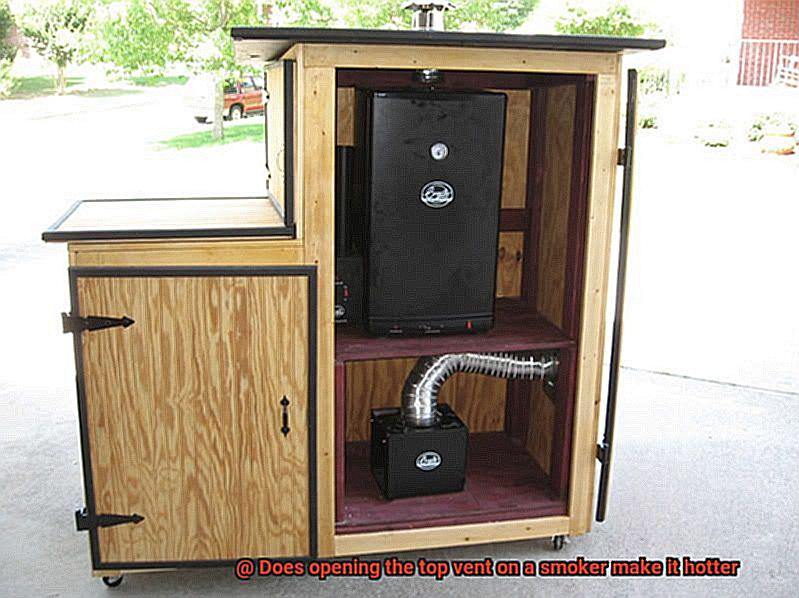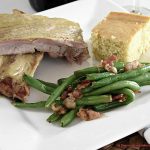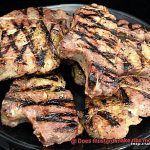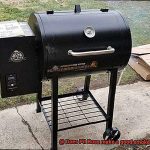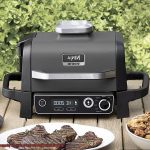Imagine this: It’s a gorgeous summer day, and the tantalizing aroma of BBQ fills the air as you fire up your smoker. But when you check the temperature, it’s not quite up to par. What do you do? Some folks swear that opening the top vent will heat things up, but is it really that simple?
This question often stumps even seasoned pitmasters. The truth is, whether or not opening the top vent will make your smoker hotter depends on a variety of factors. For some smokers, it does indeed boost the temperature; for others, there’s no noticeable difference at all.
In this blog post, we’ll dive into the mechanics of how smokers work and explore how adjusting the airflow affects temperature. We’ll also take a look at different types of smokers and how they respond to changes in ventilation. And if you’re looking to fine-tune your smoking game, we’ve got tips and tricks for nailing that perfect temp every time.
Whether you’re a die-hard BBQ enthusiast or just curious about how your smoker works, this post is for you. So grab a frosty beverage and settle in as we unpack everything you need to know about smoker vents and temperature control.
Contents
What Is a Smoker and How Does It Work?
If yes, then a smoker is an appliance you should seriously consider investing in. But before you make that decision, it’s crucial to have a solid understanding of what a smoker is and how it works.
A smoker is essentially a cooking appliance that uses smoke and low heat to cook food. It’s a popular method of cooking, especially for meats such as beef, pork, and chicken. Smokers come in different types, including charcoal, electric, and gas smokers. Each type has its own advantages and disadvantages, so it’s up to you to decide which one suits your preferences.
When it comes to the components of a smoker, there are three main parts: the firebox, cooking chamber, and smokestack. The firebox is where the fuel is burned to produce smoke, which travels through a small vent into the cooking chamber. The cooking chamber is where the food is placed for cooking while the smokestack serves as an exhaust system for the smoke and hot air.
Temperature control is essential when using a smoker. Most smokers come with two vents: one at the top and one at the bottom. You can regulate the temperature inside the smoker by adjusting these vents to control how much air flows into and out of it. Opening the top vent increases airflow through the smoker, leading to higher temperatures inside. However, other factors such as how tightly sealed the cooking chamber is also play a role.
When using a smoker, it’s important to remember that low and slow cooking is key. This means cooking your food at low temperatures for an extended period to allow it to absorb the smoky flavor while becoming tender and juicy.
Why Opening the Top Vent Makes a Smoker Hotter
Then you need to understand why opening the top vent on your smoker makes it hotter. The answer lies in the principle of convection – the transfer of heat through a fluid, such as air or smoke.
When your smoker’s top vent is closed, hot air and smoke have no escape route, creating a stagnant environment that can result in uneven cooking and smoking. But once you open that top vent, the hot air and smoke are released, creating a draft that pulls fresh oxygen into the smoker. This increased oxygen flow then causes combustion to occur more efficiently, generating more heat and smoke.
Think of it like throwing fuel onto a fire – it burns brighter and hotter. But before you get too excited and start opening that vent all the way up, remember that temperature control is crucial. Too much airflow can cause a flare-up, while too little can cause the fire to die out completely. It’s all about finding the perfect balance.
So how do you know if your smoker is getting hotter? Use a thermometer. Installing one in your smoker will help you monitor the temperature and adjust accordingly.
In summary, opening the top vent on your smoker allows for better airflow and combustion, resulting in a hotter smoking environment. Just remember to keep an eye on that thermometer and adjust as needed to prevent any fluctuations that could affect the quality of your food.
Controlling the Temperature with Adjustable Vents
As any experienced smoker knows, achieving the perfect temperature inside your smoker is key to creating delicious, tender meats. Fortunately, there’s a tool that can help you achieve this balance: adjustable vents.
Adjustable vents are one of the most effective ways to control temperature inside your smoker. By manipulating the vents, you can regulate the amount of heat and smoke that enters and exits the smoker, ensuring that your meat comes out perfectly cooked every time.
The top vent on your smoker is crucial in regulating temperature. When you open it up, more air flows through the smoker, causing the temperature to increase. Conversely, closing the top vent restricts airflow and can reduce the temperature inside the smoker. However, keep in mind that while adjusting the top vent can make your smoker hotter, it’s not the only factor that affects temperature.
The bottom vent controls airflow into the smoker and plays a critical role in maintaining your desired temperature. By opening or closing it, you can adjust the amount of oxygen that reaches the fuel source, which impacts how much heat is generated. More oxygen means more heat and faster combustion, while less oxygen means less heat and slower combustion.
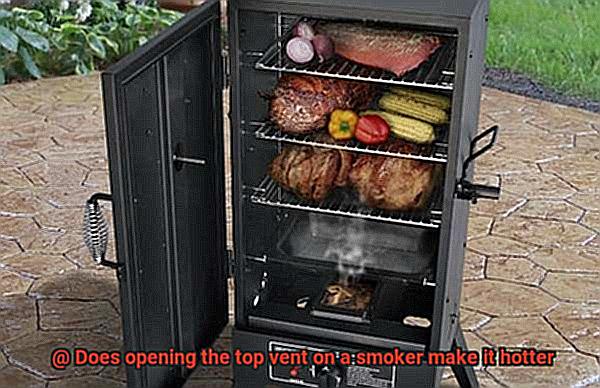
To effectively control temperature with adjustable vents, you need to understand how they work together. Most smokers have two adjustable vents – one at the top and one at the bottom. Opening both vents will increase temperature by allowing more oxygen to reach the fuel source, causing it to burn hotter and faster. Similarly, closing both vents will decrease temperature by reducing oxygen flow and slowing down combustion.
It’s important to remember that there are other factors besides adjustable vents that affect temperature. The type of fuel you use, the type of wood or charcoal you use, and your cooking method all play a role in determining temperature inside your smoker.
To become a master at controlling temperature with adjustable vents, practice and patience are key. With time, you’ll learn how to adjust both vents to achieve precise temperature control, resulting in perfectly cooked meats every time.
The Pros and Cons of Opening the Top Vent
As an expert on smoking meat, I’m here to explore the pros and cons of opening the top vent on a smoker when it comes to increasing its temperature.
Let’s start with the pros. By opening the top vent, you increase airflow, which fuels the fire and can lead to a hotter cooking temperature. This is great news if you’re short on time or have a lot of meat to smoke, as it can result in faster cooking times. Additionally, fresh air circulating through the smoker can result in a more flavorful smoke.
On the other hand, there are some potential drawbacks to opening the top vent. The increased airflow can make it harder to maintain a consistent temperature, which is a critical factor when smoking meat. If you’re not careful, fluctuating temperatures could affect the final product’s quality.
Another major concern is the risk of drying out your meat. A hotter fire means that your meat could dry out faster if not monitored carefully. This means that you need to be extra vigilant when opening the top vent and ensuring that you’re maintaining a consistent cooking temperature throughout.
Lastly, keep in mind that opening the top vent means more fuel will be needed to maintain the fire. This can lead to increased fuel consumption and higher costs in the long run. It’s something to consider if you’re budget-conscious or trying to be more eco-friendly.
Tips for Using the Top Vent Safely
When it comes to smoking meat, using a smoker with a top vent is a common way to infuse flavor and tenderness into your food. However, it’s important to use the top vent safely to prevent injuries or damage to your smoker. Here are five tips to help you use the top vent safely and effectively.
Protect Your Hands with Heat-Resistant Gloves
Opening or adjusting the top vent can expose your hands to extreme heat, which could result in burns. It’s essential to wear heat-resistant gloves that can withstand high temperatures when handling the smoker. These gloves will protect your hands from burns and enable you to adjust the vent safely.
Use Tools to Adjust the Vent
The metal on the top vent can get very hot, making it unsafe to touch with your bare hands. Instead of putting yourself at risk of burns, use tongs or spatulas to adjust the vent. This will keep you safe while enabling you to control the temperature inside the smoker.
Make Small Adjustments
When adjusting the top vent, it’s best to make small adjustments slowly and in increments. This will ensure that the temperature inside the smoker doesn’t spike suddenly, which could cause damage to your food. By making small adjustments, you can achieve precise control over the heat inside your smoker, which will result in better outcomes for your food.
Clean Your Top Vent Regularly
Like any other part of your smoker, debris and grease can build up on the top vent over time, which can affect its performance. To ensure that your smoker works correctly and safely, it’s crucial to clean the top vent regularly with a grill brush or scraper.
Follow Manufacturer Instructions
Every smoker model comes with its unique set of instructions for safe use. It’s essential always to follow these guidelines when using the top vent. They may include recommendations for how much to open the vent and how frequently to adjust it based on temperature readings. By following the manufacturer’s instructions, you can use the top vent safely and achieve the best results for your food.
Other Ways to Control Temperature in a Smoker
Smoking meat is a culinary art that requires patience and skill. To achieve the perfect flavor and texture, it’s crucial to control the temperature in your smoker. While many people believe that opening the top vent is the only way to do this, there are actually several other effective techniques you can use.
Adjusting airflow is a great way to control temperature in your smoker. The bottom vents or dampers control the amount of oxygen entering the smoker, which affects the temperature. By partially closing these vents, you can reduce the amount of oxygen entering the smoker, lowering the temperature. Conversely, opening them wider will increase airflow and raise the temperature.
Water or a heat sink is another effective technique for controlling temperature. Adding a pan of water or a heat sink like a cast-iron skillet to your smoker can help regulate the temperature by absorbing and releasing heat. The water or heat sink will absorb some of the heat, preventing it from building up in the smoker and causing it to overheat.
Fuel levels can also be adjusted to control temperature in your smoker. Adding more fuel will increase heat, while reducing fuel will lower it. However, adding too much fuel can cause flare-ups and create uneven temperatures in your smoker.
Lastly, using a digital thermometer to monitor the temperature inside your smoker is an essential technique. This will allow you to make adjustments as needed and ensure that your meat is cooking at the right temperature.
Common Mistakes to Avoid When Using a Smoker
Using a smoker can be an incredibly rewarding experience, but it can also lead to frustration if you’re not aware of the common mistakes to avoid. As an expert in the art of smoking, I’m here to share some tips on common mistakes to avoid when using a smoker.
First things first: preheat your smoker. This is an important step that many people overlook. Preheating your smoker ensures that it’s at the right temperature before you start cooking and helps avoid undercooked or unevenly cooked food.
Another common mistake is using too much wood. While we all love that smoky flavor, overdoing it can make your food taste bitter and overpowering. To avoid this, use the right amount of wood for the type of meat you’re cooking.
Now for a tough one: resist the urge to open the lid too often. Checking on your food frequently can cause fluctuations in temperature and extend the cooking time. Keep the lid closed as much as possible and only open it when necessary.
Using a meat thermometer is another crucial step in ensuring that your food is cooked properly and safe to eat. Don’t rely on guesswork or visual cues—use a meat thermometer every time.
Lastly, make sure to clean your smoker regularly. Buildup from previous cooks can affect the flavor of your food and make it less enjoyable. A clean smoker is essential for great-tasting food every time.
CuVIwLv30tI” >
Conclusion
In summary, the top vent of a smoker can undoubtedly make it hotter, but it’s not a one-size-fits-all solution. The type of smoker and how well-sealed the cooking chamber is are both crucial factors to consider. When you open the top vent, you increase airflow, which leads to more efficient combustion and generates more heat and smoke. However, too much airflow can cause a flare-up, while too little can cause the fire to die out completely.
The adjustable vents are an excellent tool for controlling temperature inside your smoker. By manipulating both the top and bottom vents, you can regulate the amount of heat and smoke that enters and exits the smoker. This ensures that your meat comes out perfectly cooked every time.
While using a smoker with a top vent, safety should be your top priority. You must use it safely to prevent injuries or damage to your smoker. To do this, protect your hands with heat-resistant gloves, make small adjustments in increments, clean your top vent regularly, and follow manufacturer instructions.
There are other techniques for controlling temperature in a smoker besides adjusting airflow through bottom vents or dampers. Adding water or a heat sink helps regulate temperature by absorbing and releasing heat. Adjusting fuel levels by adding or reducing fuel accordingly also works well. Additionally, using a digital thermometer to monitor temperature inside the smoker is an effective way to ensure perfect results every time.
Lastly, there are common mistakes that people make when using their smokers that you should avoid at all costs. Preheating your smoker before cooking is essential as it helps eliminate any impurities that may affect taste or quality. Using too much wood could lead to over-smoking of meat; therefore, use only what’s necessary for flavoring purposes. Resisting the urge to open the lid too often maintains consistent temperatures inside the smoker while using a meat thermometer every time you cook meat ensures that you serve properly cooked food every time.

